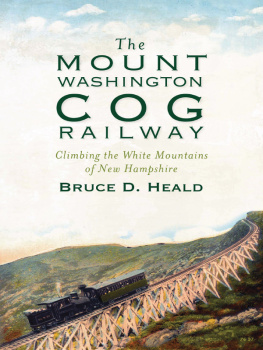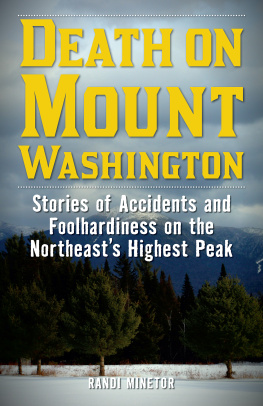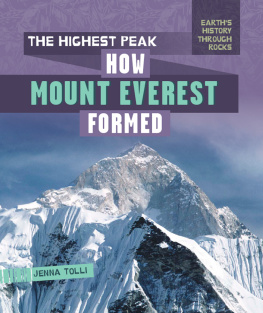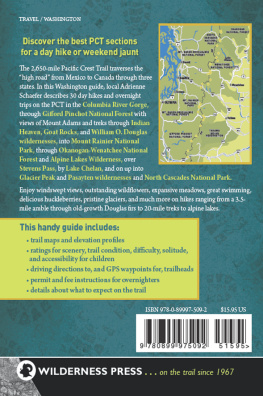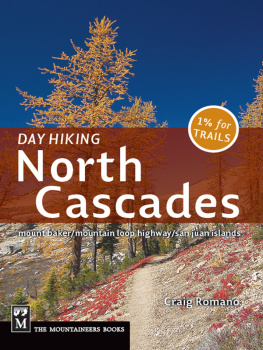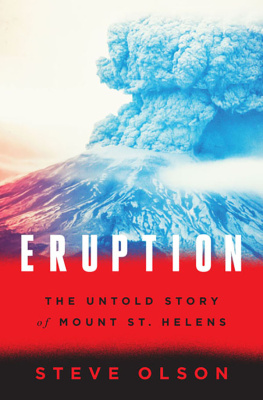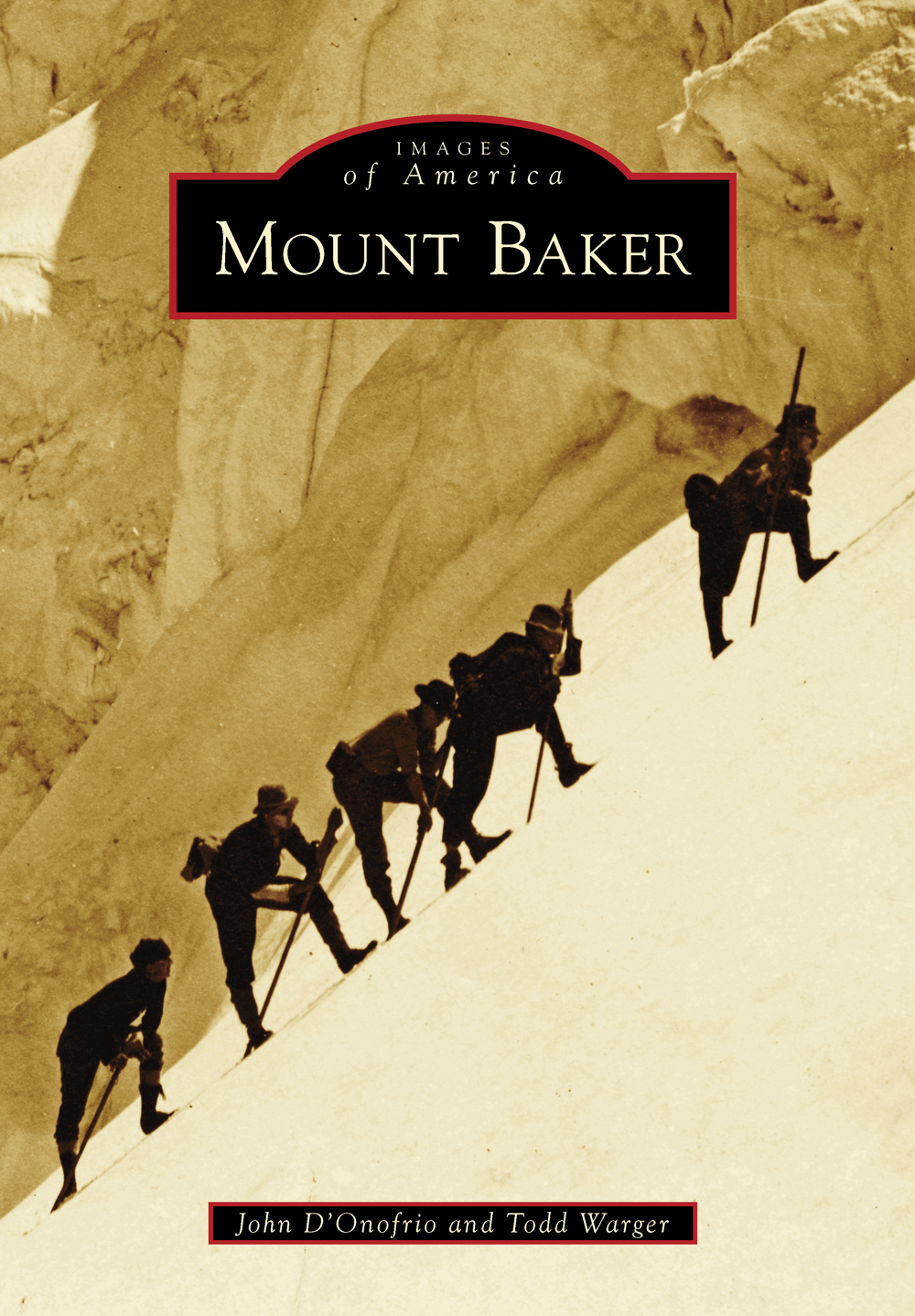
IMAGES
of America
MOUNT BAKER

Mighty Joe Morovits was a legend around Mount Baker. Famous for incredible feats of strength and audacity, he once hauled a piece of mining machinery weighing 2,300 pounds from the town of Concrete to his cabin, a distance of 21 miles. When the task proved too difficult for his team of horses, he winched the machine from tree to tree. The effort took two years. (Courtesy of the Whatcom Museum.)
ON THE COVER: Members of the Mazamas Mountaineering Club pause on the Roman Wall, just below the summit plateau of Mount Baker. The Mazamas, formed in 1894, played an important role in the history of climbing in the Pacific Northwest, registering many first ascents. (Courtesy of Gordy Tweit.)
IMAGES
of America
MOUNT BAKER
John DOnofrio and Todd Warger

Copyright 2013 by John DOnofrio and Todd Warger
ISBN 978-1-4671-3107-0
Ebook ISBN 9781439644447
Published by Arcadia Publishing
Charleston, South Carolina
Library of Congress Control Number: 2013943967
For all general information, please contact Arcadia Publishing:
Telephone 843-853-2070
Fax 843-853-0044
E-mail
For customer service and orders:
Toll-Free 1-888-313-2665
Visit us on the Internet at www.arcadiapublishing.com
For Susan DOnofrio and Renee Sherrer, embodying the roles of muse, critic, and enlightened confidant
CONTENTS
ACKNOWLEDGMENTS
The authors want to thank the following individuals and institutions for their support in opening their private photographic collections and providing invaluable information that made this book possible: Jeff Jewell, Dawn Buckenmeyer, Laura Jacoby, Margaret Hellyer, David Tucker, John Scurlock, Michael Impero, Sarah Gabl, Gordy Tweit, John Miles, Gail Everett, Wes Gannaway, Sherman and Liz Ousdale, Steve Mayo, Gwyn Howat, Amy Trowbridge, Brett Baunton, Mel Monkelis, Whatcom Events, Deming Library, Whatcom Museum, Mount Baker Ski Area, the Bellingham Herald, and the National Archives Records Administration. Virtuoso photographic assistance was provided by Al Sanders and Jeff Daffron of Quicksilver Photo Labs, and vital technical aid was provided by Ethan DOnofrio. Special thanks to Doug Banner, Randy and Claudia DeWees, Joe Jowdy, Barb Hansen, Rich Vanderwyst, Lance Ekhart, Denise Snyder, Marian DOnofrio, and Christopher, somewhere in Uganda. We also wish to especially thank our editor at Arcadia Publishing, Rebecca Coffey, who kept us on track throughout the project.
INTRODUCTION
A dormant, but definitely not extinct volcano, Mount Baker dominates the landscape like few other peaks in the lower 48. At 10,781 feet, it is the third-highest mountain in the state of Washington and the second most heavily glaciated peak in the contiguous United States. For the native populations that lived in its shadow for millennia, it was sacred ground. For the miners and loggers who ventured ever closer to its mantle of ice and snow in their quest for gold and timber, it represented the mother lode; untapped riches for the taking. For the first climbers seeking its elusive, windswept summit, it was an opportunity for glory and triumph on a grand scale. For the businessmen of the 19th century, it was a blank canvas on which they hoped to paint a picture of prosperity and wealth. Mount Baker has always been more than its epic geography. Mount Baker is a state of mind.
The land around the mountain was paradise for the original inhabitants. The Lummi, Nooksack, Samish, Skagit, and Semiahmoo tribes enjoyed a wealth of natural resources provided by land and sea. They learned the mountains secrets and built complex, richly nuanced cultures that celebrated the natural world and their place in it, finding a balance that nourished their physical and spiritual needs. They were inspired to create elaborate mythologies and beautiful artifacts that honored the mountain, forests, rivers, and sea.
Beginning with the Spanish explorer Manuel Quimper in 1790, Europeans entered the scene. Capt. George Vancouver arrived two years later and bestowed the name upon the mountain by which it is known today. Thus began an era of exploration and colonization that slowly penetrated the dense forests that surrounded the mountain. This advance was slow but relentless. Gradually, newcomers established homesteads on the wild, big-hearted rivers, built villages beneath the towering trees, and began to tentatively venture higher and higher, reaching for heights both real and metaphorical.
As the population around Bellingham Bay grew, industries sprang up. Mining, fisheries, timbereach had their day in the sun, and each brought both prosperity and heartbreak. Beginning in the 1890s, the Mount Baker Gold Rush lured countless rough-and-ready prospectors, eager to strike it rich in the gold fields north of the mountain. Businesses created to supply these men with equipment and provisions sprang up overnight, giving birth to new towns around the mountain. The miners lives were almost unbelievably hard and, for most, unrewarded by the elusive big strike. But the trails that they gouged out of the wilderness would become wagon roads and, eventually, highways.
The loggers who made their lives among the great cedars and firs also suffered almost unthinkable deprivations, and the dangers they faced on a daily basis maimed and killed with shocking regularity. As their efforts became more and more mechanized through the introduction of the railroads, the steam donkey, and the chainsaw, the loggers reach was extended. Inevitably, of course, the resource they sought diminished commensurately. In less than 100 years, the virgin forests were gone.
Adventure-seekers arrived at the mountain with dreams of a different kind. They were drawn by the chance to stand where none had stood before, to see the world from high and lonely places, to breathe the rarified air of terra incognita. Their efforts were also defined by struggle, danger, and adversity. Many sought the prize of conquest, but few attained it. More than a few died in the pursuit. Edmund T. Coleman was the first to reach the summit of Mount Baker when he surmounted the Roman Wall on August 17, 1868. Coleman had the right stuff. His first two attempts had ended in failure, but he learned from his mistakes and was rewarded with the euphoria of a dream fulfilled.
As the 19th century was winding down, the territory that would become Washington State was booming. From 1879 to 1889, its population grew by 365 percent. In the waning years of the century, two events of great portent occurred. On November 11, 1889, Washington was admitted into the Union as the 42nd state, and on March 2, 1899, Mount Rainier became the United States fifth national park. Together, these two events set the stage for a form of commerce as yet unknown in the new state: tourism.
To capitalize on this new phenomenon, the Mount Baker Marathon was conceived to draw attention to the region. It was one of the most audacious schemes of its kind ever devised. The year was 1911, and Arthur J. Craven, the president of the Mount Baker Club, had dreams of riches and visions of national prominence that might translate into his favorite music: the ringing of cash registers. Much like the story of Mount Baker itself, it was a story of greed and triumph, heroism and near-disaster.
As a publicity stunt designed to further the establishment of a national park at Mount Baker to compete with Mount Rainier, the marathon was a failure. But as a symbol of the civic determination and never-say-die attitude of the community, its dramatic impact cannot be denied.
Next page

